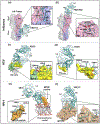VH1-69 antiviral broadly neutralizing antibodies: genetics, structures, and relevance to rational vaccine design
- PMID: 30884330
- PMCID: PMC7266006
- DOI: 10.1016/j.coviro.2019.02.004
VH1-69 antiviral broadly neutralizing antibodies: genetics, structures, and relevance to rational vaccine design
Abstract
Broadly neutralizing antibodies (bnAbs) are potential therapeutic molecules and valuable tools for studying conserved viral targets for vaccine and drug design. Interestingly, antibody responses to conserved epitopes can be highly convergent at the molecular level. Human antibodies targeting a number of viral antigens have often been found to utilize a restricted set of immunoglobulin germline genes in different individuals. Here we review recent knowledge on VH1-69-encoded antibodies in antiviral responses to influenza virus, HCV, and HIV-1. These antibodies share common genetic and structural features, and often develop neutralizing activity against a broad spectrum of viral strains. Understanding the genetic and structural characteristics of such antibodies and the target epitopes should help advance novel strategies to elicit bnAbs through vaccination.
Copyright © 2019 Elsevier B.V. All rights reserved.
Figures


Similar articles
-
Mapping of a Novel H3-Specific Broadly Neutralizing Monoclonal Antibody Targeting the Hemagglutinin Globular Head Isolated from an Elite Influenza Virus-Immunized Donor Exhibiting Serological Breadth.J Virol. 2020 Feb 28;94(6):e01035-19. doi: 10.1128/JVI.01035-19. Print 2020 Feb 28. J Virol. 2020. PMID: 31826999 Free PMC article.
-
Functional convergence of a germline-encoded neutralizing antibody response in rhesus macaques immunized with HCV envelope glycoproteins.Immunity. 2021 Apr 13;54(4):781-796.e4. doi: 10.1016/j.immuni.2021.02.013. Epub 2021 Mar 5. Immunity. 2021. PMID: 33675683 Free PMC article.
-
Coevolution of HIV-1 and broadly neutralizing antibodies.Curr Opin HIV AIDS. 2019 Jul;14(4):286-293. doi: 10.1097/COH.0000000000000550. Curr Opin HIV AIDS. 2019. PMID: 30994504 Free PMC article. Review.
-
Structure-Based Design of Hepatitis C Virus Vaccines That Elicit Neutralizing Antibody Responses to a Conserved Epitope.J Virol. 2017 Sep 27;91(20):e01032-17. doi: 10.1128/JVI.01032-17. Print 2017 Oct 15. J Virol. 2017. PMID: 28794021 Free PMC article.
-
Broadly Neutralizing Antibodies against HIV: Back to Blood.Trends Mol Med. 2019 Mar;25(3):228-240. doi: 10.1016/j.molmed.2019.01.007. Epub 2019 Feb 18. Trends Mol Med. 2019. PMID: 30792120 Free PMC article. Review.
Cited by
-
Extraction of the CDRH3 sequence of the mouse antibody repertoire selected upon influenza virus infection by subtraction of the background antibody repertoire.J Virol. 2024 Mar 19;98(3):e0199523. doi: 10.1128/jvi.01995-23. Epub 2024 Feb 7. J Virol. 2024. PMID: 38323813 Free PMC article.
-
Pathogenic autoantibodies to IFN-γ act through the impedance of receptor assembly and Fc-mediated response.J Exp Med. 2022 Sep 5;219(9):e20212126. doi: 10.1084/jem.20212126. Epub 2022 Jul 14. J Exp Med. 2022. PMID: 35833912 Free PMC article.
-
Proof of concept for rational design of hepatitis C virus E2 core nanoparticle vaccines.Sci Adv. 2020 Apr 15;6(16):eaaz6225. doi: 10.1126/sciadv.aaz6225. eCollection 2020 Apr. Sci Adv. 2020. PMID: 32494617 Free PMC article.
-
virusMED: an atlas of hotspots of viral proteins.IUCrJ. 2021 Sep 28;8(Pt 6):931-942. doi: 10.1107/S2052252521009076. eCollection 2021 Nov 1. IUCrJ. 2021. PMID: 34614039 Free PMC article.
-
Functional, Immunogenetic, and Structural Convergence in Influenza Immunity between Humans and Macaques.bioRxiv [Preprint]. 2025 Feb 27:2025.02.21.639368. doi: 10.1101/2025.02.21.639368. bioRxiv. 2025. PMID: 40568173 Free PMC article. Preprint.
References
-
- Edwards VC, Tarr AW, Urbanowicz RA, Ball JK: The role of neutralizing antibodies in hepatitis C virus infection. J Gen Virol 2012, 93:1–19. - PubMed
-
- Janiak M, Caraballo Cortes K, Demkow U, Radkowski M: Spontaneous elimination of hepatitis C virus infection. Adv Exp Med Biol 2018, 1039:45–54. - PubMed
Publication types
MeSH terms
Substances
Grants and funding
LinkOut - more resources
Full Text Sources
Other Literature Sources
Medical

